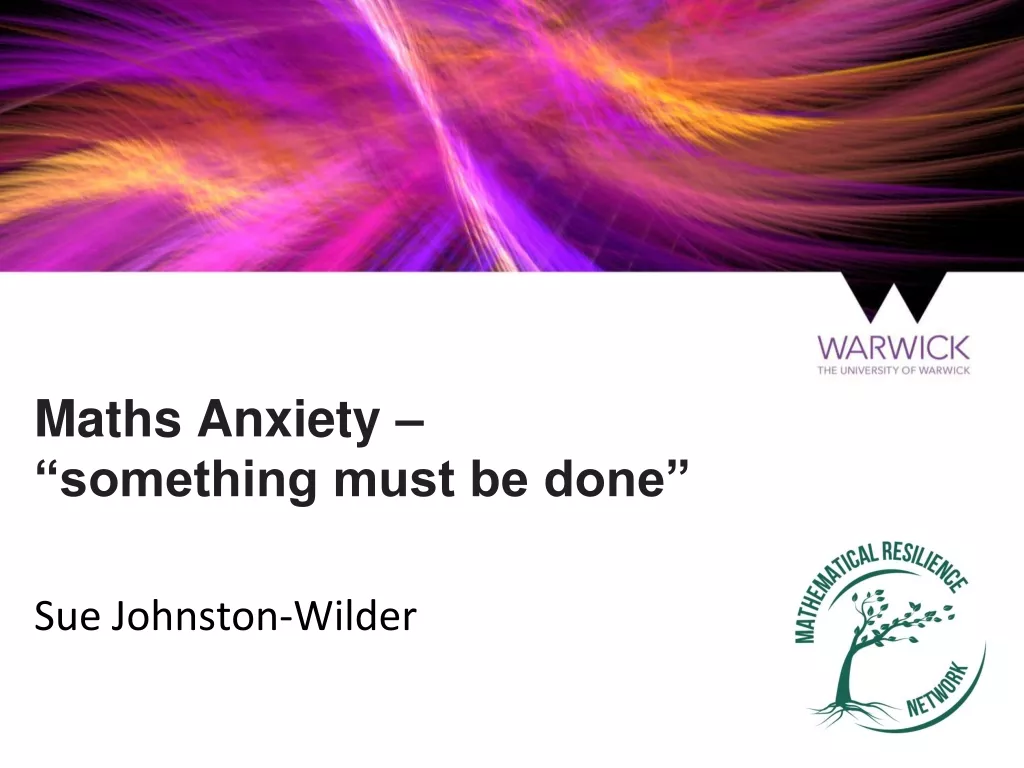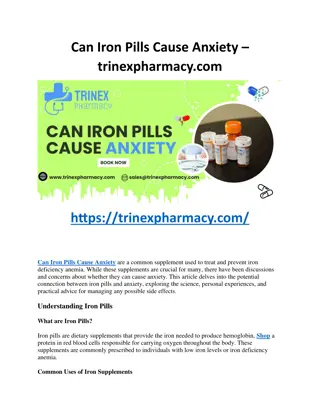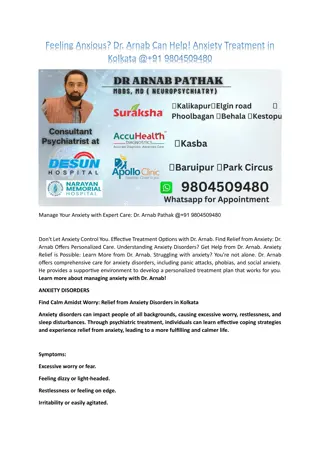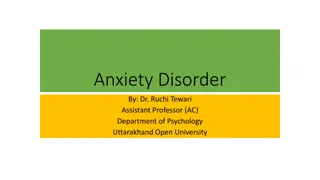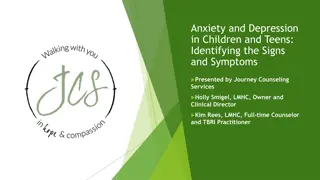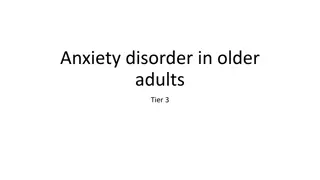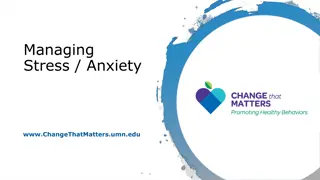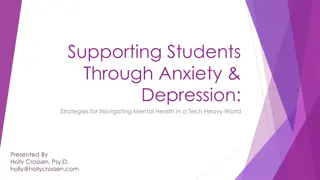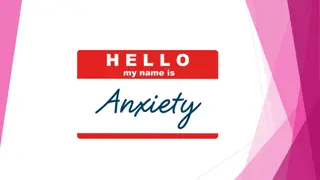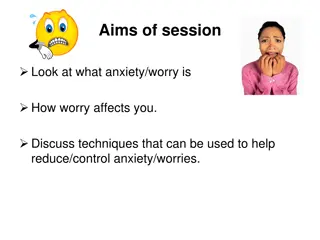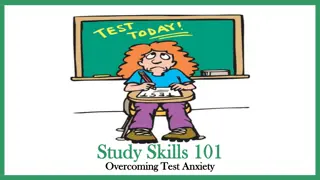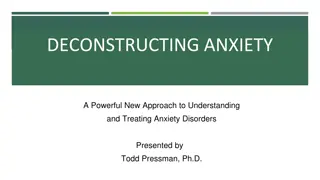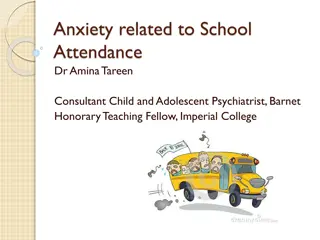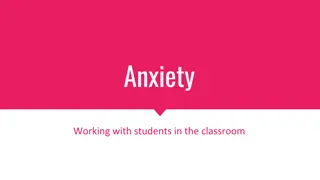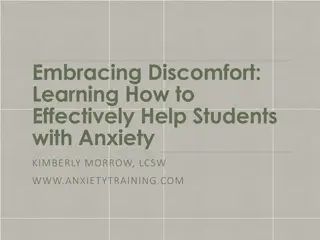Understanding Anxiety Among Health Science Students
Research highlights a significant increase in anxiety and depression among health science students, impacting their well-being and academic performance. Challenges in counseling students in this field may include managing academic pressures, competitive program entrance, and personal life events. Effective counseling services and best practices are crucial to address the mental health needs of these students. The growing demand for health professionals underscores the importance of supporting students in this high-stress field.
Uploaded on Oct 06, 2024 | 0 Views
Download Presentation

Please find below an Image/Link to download the presentation.
The content on the website is provided AS IS for your information and personal use only. It may not be sold, licensed, or shared on other websites without obtaining consent from the author. Download presentation by click this link. If you encounter any issues during the download, it is possible that the publisher has removed the file from their server.
E N D
Presentation Transcript
Reality Therapy with Anxious Reality Therapy with Anxious Health Science Students Health Science Students Gina Barthelemy-Morton, M.Ed., LPC, NCC CTC Associate Dean of Health Sciences Owner of Road to Restoration Counseling Services
Objectives Summarize and Review Research of increased Anxiety amongst Health Sciences Students Describe challenges of counseling Health Sciences students Best practices in delivering counseling services
Anxiety Statistics Students present with an increase of anxiety and depression. In 2014, CCC s reported an 89% increase in students presenting with anxiety disorders over the past 5 years. According to Healthy Minds Study in 2016-2017 44% of students said they were flourishing 39% reported experiencing symptoms of depression and anxiety
Research Says Students pursuing healthcare education have stressors that may include: Entrance to competitive programs Managing academic pressures Workload of the program Personal life events
Chattahoochee Tech Spring 2020 Semester 9,885 students enrolled Health Sciences Division has combination of both pre-health and health students totaling of 1925 students Health sciences tends to have 1/3 of the student population PN BRIDGE ASN RAD PTA/OTA Paramedicine/ HCM EMT Health sciences ST MA CLT PRE HEALTH PCT CNA
Increase need of Health Professionals HEALTH CARE CONTINUES TO BE THE MOST RISING EMPLOYMENT EMPLOYMENT OF HEALTHCARE OCCUPATIONS IS PROJECTED TO GROW 14% FROM 2018 TO 2028 THE PROJECTED GROWTH OF JOBS IN HEALTH CARE SETTINGS (18 %) WILL CONTINUE TO BE FAR MORE RAPID THAN IN THE REMAINDER OF THE ECONOMY, WHICH IS PROJECTED TO GROW AT A RATE OF 6 PERCENT. HEALTH CARE JOBS ARE STILL PROJECTED TO GROW AT 3X THE RATE OF THE REST OF THE ECONOMY DURING THE NEXT DECADE. ALMOST SEVEN TIMES FASTER THAN THE REST OF THE ECONOMY.
Employment Shift and Education Standards Increase of Students Pursuing Health Related fields Increases of their Stressors Increase need of Health Workers
Dr. William Glasser The theorist behind the therapy! An American Psychiatrist who developed Choice Theory and Reality Therapy Earned a B.S in Chemical Engineering in 1945 M.A. in Clinical Psychology in 1949 MD in Psychiatry in 1953 from Case Western Reserve University in Cleveland, OH.
William Glasser Reality Therapy Reality Therapy is the method of counseling that has been taught since 1965 Based upon Choice Theory Benefits include Focus on present Focus on what can be done/accomplished Remain non-judgmental Create specific and workable plans
Why Reality Therapy Helping students refocus to the here-and-now Emphasis on making decisions and taking appropriate action Allowing students to see a different perspective of their choices
WDEP Exercise WANTS DOING EVALUATE PLAN
Research Given the importance of healthcare graduate students ability to manage anxiety, stress, depression, compassion, and mindfulness related to academic performance, patient relationships, and clinical competence, it seems that a comprehensive approach to measuring these areas would lead to greater understanding of the implementation of such programs within undergraduate healthcare education.
Psychosocial Predictors of Wellness in College Students College students work toward personal and professional development through: cultivating their identities pursuing career interests developing relationships
Many students concerns today differ from previous generations Burwell relates some of the stressors to derive from three factors: Safety Economics Technology Generation Stress
Burwell Research Says Seek more adult guidance than previous generations More come to college with less mastery of life skills Have an inability to cope with failure and disappointment Prevention, Detection and Treatment Create a sense of community and belonging on campus
Biopsychosocial-Spiritual Model of Self-Care Healthcare practictioners with lower levels of anxiety and depression and higher levels of empathy may have better provider-patient relationships and clinical competence. Higher level of mindfulness showed overall improvements in patient satisfaction Training in salutogenesis is limited(Klawonn, A., Kernan, D., & Lynskey, J. (2019). This Photo by Unknown Author is licensed under CC BY
Effects of stress Decreased academic performance Decrease of self-care Diminished empathy when working with others (empathy is an important piece of connection between clinician and patient) Increased depression and interpersonal distress Medical students w/ elevated levels demonstrated declines in professionalism
Prevalence of Anxiety Females have higher anxiety levels than their male counterparts. Females are twice as likely to have an anxiety disorder than men. Anxiety was increasingly higher to second year students than first year students Clinical Rotations Licensure
Predicting Anxiety Financial distress was linked to poorer levels of mental health in students and psychiatric disorders A lower self-reported GPA was associated with higher anxiety scores A personal hx of anxiety and family history of anxiety were also significant predictors of anxiety
Health Sciences Programs Recommendations Due to accrediting bodies many health programs require a myriad of services be offered to these students including counseling and disability services Decrease the emphasis on GPA s to assist reducing anxiety and improving learning experiences.
Techniques for Reducing Anxiety Self-regulation Use of counseling services on campus Increase Self-Care Mindfulness Use of Creative Arts Interventions for Stress Mgmt & Prevention
MBSR reducing Anxiety Mindfulness-Based Stress Reduction (MBSR) A 4-30 minute training session produced: Positively affected homework, exhaustion, satisfaction with life, and relaxation in nurses and nurse aides. Decreased perceived stress in first and second year medical students Increases self-compassion Increases in distress tolerance 6 week MBSR 6 -90 minute classes plus homework such as journaling found: Increase in mindfulness, well- being, emotional intelligence Decrease in perceived stress, depression and anxiety
Creative Arts Therapies/Interventions Art Music Dance Theater
Counselors Help Counselors can help students both accentuate their psychosocial strengths and work on their unresolved developmental goals to pursue a healthy wellness lifestyle. Students should examine their stages of development and gain insight into why they exceeded in some goals and struggled to meet others.
How College Counselors Can Help this Population Counselors have a great responsibility to help prepare future practitioners Create a Reality Based Environment for Health Students where resiliency can be cultivated and achieved
Practice Case Study Veronica is a 26y/o transfer student that was recently accepted into a two-year technical college in pursuits of a career in health. After attending New Student Orientation she learns about the requirements to apply to the Associate of Science in Nursing Program. Veronica meets with you at the Counseling Center and shares with you her desires of becoming a Registered Nurse and wants to know how she may be able to bypass the requirements and be accepted at the end of this year to the nursing program? She states she has the majority of the pre-requisites completed and transferred but she is not a strong or competitive applicant due to the grades earned in those coursework. She has also shared with you that she has experienced test anxiety and recently diagnosed with GAD. How might you use Reality Therapy or Choice theory to assist Veronica and ground back to the here and now?
Summary Health Careers are projected to have faster growth rate than the rest of the economy. Health professions education students have significantly elevated anxiety levels compared to normative values Anxiety places the students at risk for health consequences and learning deficits The impact of anxiety may extend beyond personal detriment into their new found career choice Helping our students with their choices, and decreasing their anxiety allows the greater opportunities to better themselves as healthcare providers
FUTURE INIATIVES Limited research available on 2 year accelerated programs and anxiety experienced by these students Continue research to determine effects of stress in students attending accelerated two-year programs Provide evidence to student body importance of self- regulation, mindfulness, and self-care Offer activities for students in Health Sciences to dispel anxiety and learn effective coping strategies that will be used in future health career field.
CONTACT INFORMATION Gina Barthelemy-Morton M.Ed, LPC, NCC Chattahoochee Technical College Associate Dean of Health Sciences (770) 529 -3733 gmorton@chattahoocheetech.edu Owner of Road to Restoration Counseling Services, LLC (770) 609-7262 ginabmorton@roadtorestorationcounseling.com
References Burwell, S. M. (2018). Generation Stress: The Mental Health Crisis on Campus. Foreign Affairs, 97(6), 150 157. Retrieved from https://search.ebscohost.com/login.aspx?direct=true&AuthType =ip,shib&db=fth&AN=132341938&site=eds-live&scope=site Klawonn, A., Kernan, D., & Lynskey, J. (2019). A 5-Week Seminar on the Biopsychosocial-Spiritual Model of Self-Care Improves Anxiety, Self-Compassion, Mindfulness, Depression, and Stress in Graduate Healthcare Students. International Journal of Yoga Therapy, 29(1), 81 89. https://doi.org/10.17761/D-18-2019- 00026
References Kelly Macauley, Laura Plummer, Charlotte Bemis, Genevieve Brock, Christine Larson, & Johanna Spangler. (2018). Prevalence and Predictors of Anxiety in Healthcare Professions Students. Health Professions Education, (3), 176. https://doi.org/10.1016/j.hpe.2018.01.001 Martin, L., Oepen, R., Bauer, K., Nottensteiner, A., Mergheim, K., Gruber, H., & Koch, S. C. (2018). Creative Arts Interventions for Stress Management and Prevention--A Systematic Review. Behavioral Sciences (2076-328X), 8(2), 28. https://doi.org/10.3390/bs8020028
References Robino, A., & Foster, T. (2018). Psychosocial Predictors of Wellness in College Students. Adultspan Journal, 17(1), 3 13. https://doi.org/10.1002/adsp.12049 Ruzhenkova, V. V., Ruzhenkova, V. A., Lukyantseva, I. S., & Anisimova, N. A. (2018). Academic stress and its effect on medical students mental health status. Drug Invention Today, 10(7), 1171 1174. Retrieved from https://search.ebscohost.com/login.aspx?direct=true&AuthType =ip,shib&db=a9h&AN=130629160&site=eds-live&scope=site
References https://www.bls.gov/ooh/healthcare/home.htm


